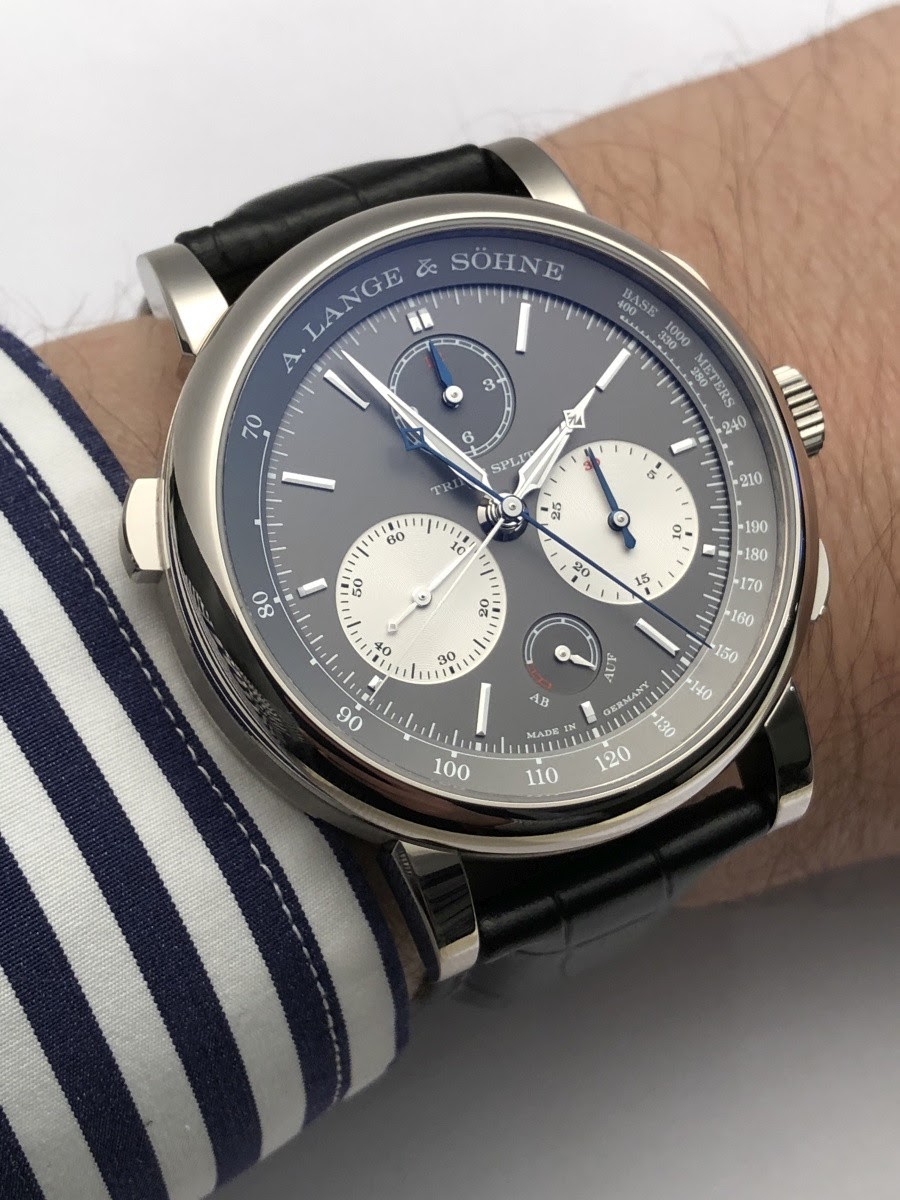
Hands on review of the Lange & Söhne Triple Split
foversta


There is a special relationship between Lange & Söhne and the chronograph calibres it designs. In my opinion, the chronograph is its favorite complication because very rarely a High Horology brand has reached such a level of excellence and control in the development and execution of these movements. Don't be wrong. A chronograph caliber belonging to the top of the watchmaking pyramid is extremely complex to develop, much more for example than a minute repeater (what some watchmakers can confirm). Because, unlike the latter, which is a complication working one sequence at a time, the chronograph uses mechanisms that work together and whose respective operations must not be disturbed. Moreover, the interaction between the user and the movement must be perfect: the precision of the starting, stopping, resetting steps is required so that the time measurement is as accurate as possible.
Lange & Söhne has marked the history of the contemporary chronograph (at least) twice: with the release of the Datograph in 1999 and with the presentation of the Double Split in 2004. The Datograph redefined how should be ideally the classic chronograph of the high end segment, with a low frequency and a jumping minute counter. The movement was not just a treat for the eyes. It was also totally adapted to a daily use thanks to the very enjoyable winding experience, the perfect sensation caused by the use of the pushers and the flyback feature. The Double Split was created in a similar context but with a higher frequency (3hz vs 2.5hz) and especially by making the "rattrapante" function much more useful because it could measure the additive and comparative times up to 30 minutes: it was the first watch to offer such a performance. Rarely a watch has worn a name describing it so well: Double Split evokes the double-rattrapante mechanism symbolized by the two pairs of hands (those of the seconds and minutes of the chronograph) which separate ... and gather according to the use of the chronograph, for example to measure intermediate times or the performance of two competitors.
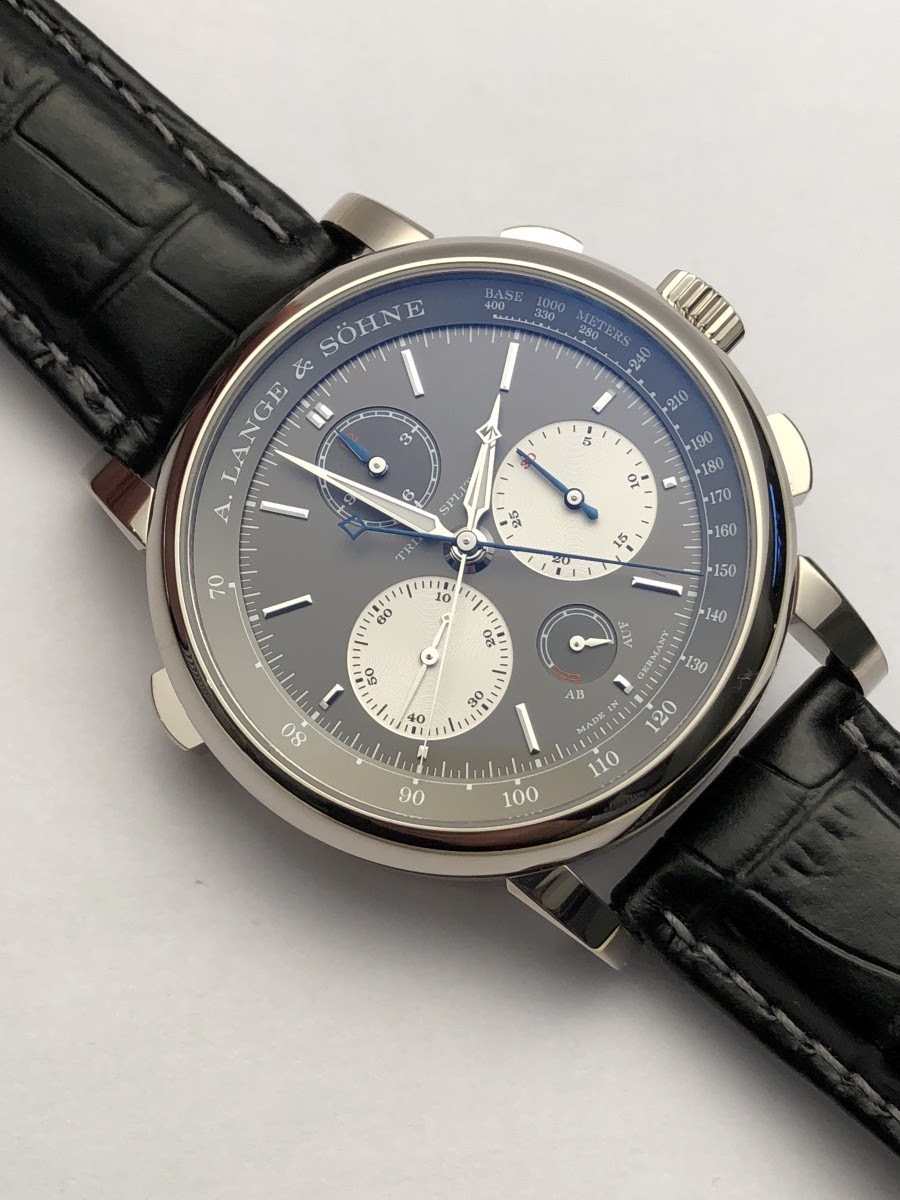
The Double Split was until now considered as the ultimate chronograph, because of its technical characteristics, its size, its finishes. But it has just found a successor with the Triple Split which was unveiled a few days ago in Geneva during the last SIHH.
The Triple Split is not difficult to explain: it is totally in line with the Double Split. Triple Split as triple-rattrapante and, after the seconds and minutes, the hours are now the subject of the same treatment. The consequence is quite logical: thanks to the ability of splitting the hands from the hours counter, the Triple Split is able to measure additive and comparative times over a period of 12 hours. The use of the Triple Split is identical to that of the Double Split: the rattrapante pusher is located close to 10 o'clock while the pushers for starting, stopping and resetting the chronograph are located on the right caseside.
On the other hand, the presentation of the dial changes between the Double Split and the Triple Split. Admittedly, I find again the two sub-dials which are slightly off-centered down: the left one is dedicated to the permanent second hand, the right one to the minute counter of the chronograph. In the same way the flange is still occupied by the tachymeter scale. The small displays bring the true novelty. First, the power reserve indicator goes from the top of the dial to its bottom. The Triple Split therefore uses a similar configuration than the Datograph Up & Down with this position. Then, the top of the dial is now occupied by the brand new hours counter that embodies the transition from Double to Triple Split.
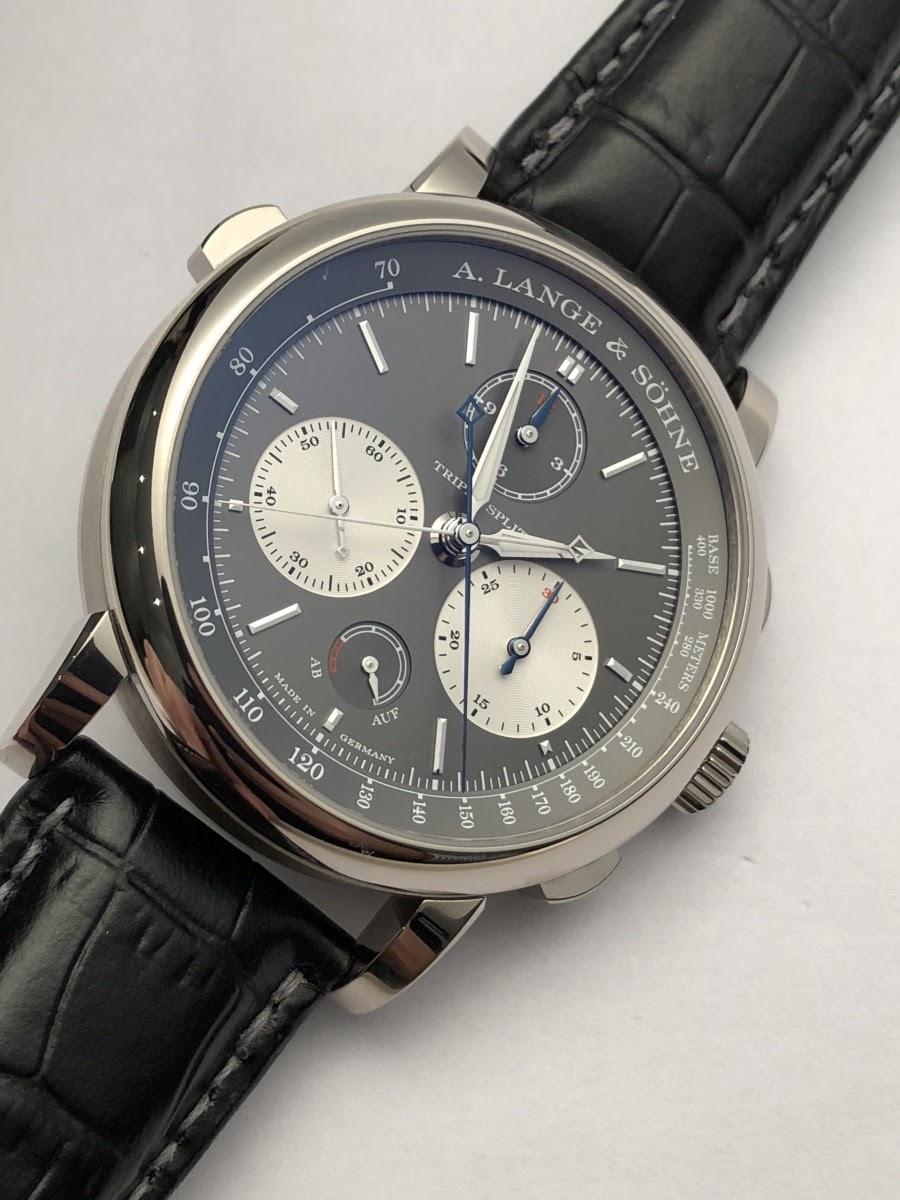
So, perhaps to make a clearer difference between these two watches, Lange & Söhne made the decision to use a colors range that was not used with the Double Split. In a strange way I must confess, the first version of the Triple Split is released in white gold. I expected, considering the exclusive nature of the watch (edited in the context of a limited series of 100 pieces) and the prestige of the complication that a platinum case should be dedicated to it. The gray dial (a consistent color with the white gold case for Lange & Söhne) defines a very different style from that of the Double Split. Fortunately, the contrast remains between the dial and the sub-dials even if it is less clear than with the black dial of the Double Split in platinum. The manufacture was also keen to bring a nice contrast between the rattrapante and the chronograph hands. The hands of the rattrapante function, in blued steel, are distinctly distinguished from those of the chronograph, which are made of rhodium-plated steel. I really liked the design of the dial, very elegant and in my opinion, more refined than the Platinum Double Split. The Roman numerals of the first version of the Double Split don't come back (it was already the case with latter versions of the Double Split) but it is for the good cause: there isn't any space left and Lange ensured that the case dimensions remain almost identical.
The real performance is at this level: despite the addition of a "split" hours counter, despite the increase in the power reserve from 38 to 55 hours, the size of the movement of the Triple Split is similar to that of the Double Split. Its diameter is the same (30.6mm) and it even has the luxury of being thinner (9.4mm vs 9.5mm). So, the logical consequence is that the case of the Triple Split has the same diameter than the Double Split one (43,2mm) but, because of the additional display which must oblige to slightly raise the main hands, its thickness is slightly higher ( 15.6mm vs 15.3mm). We almost don't feel any difference between the two cases!
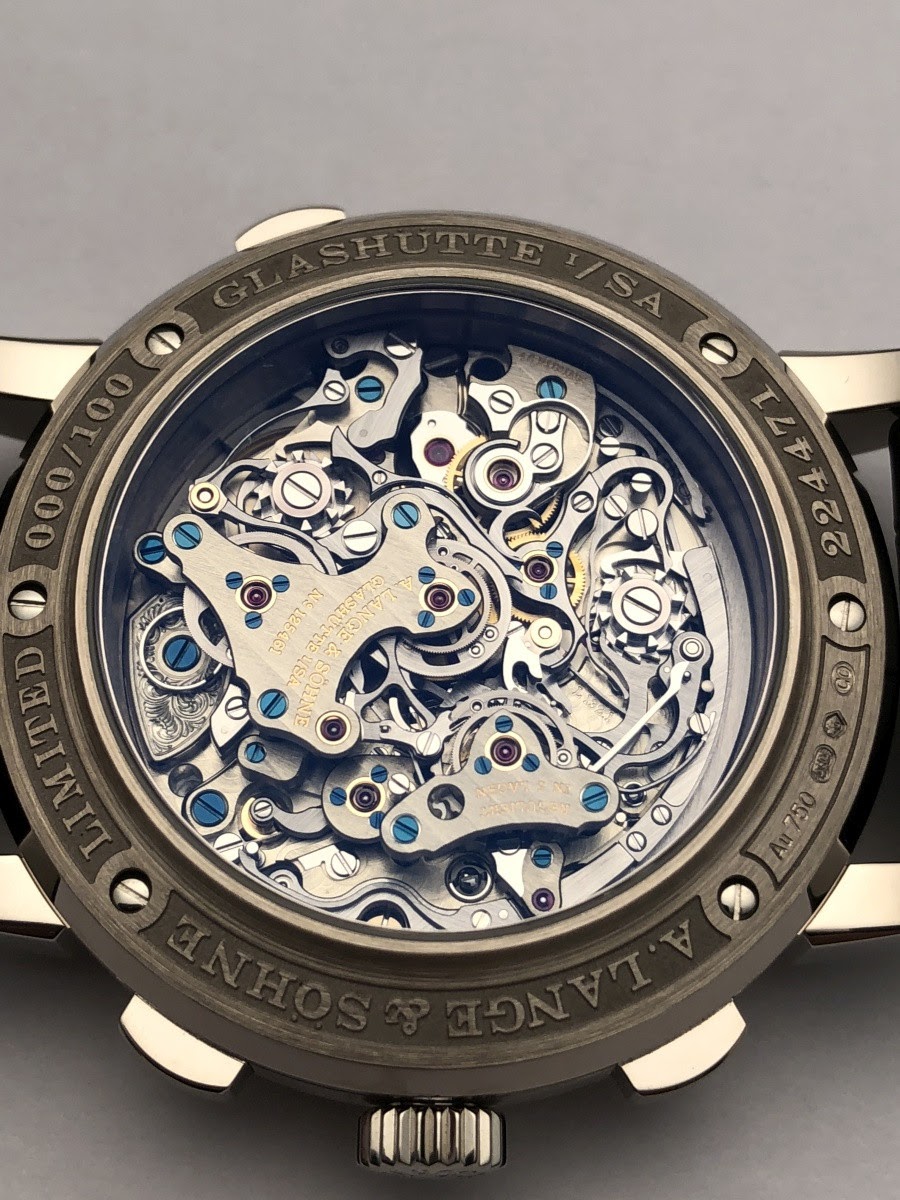
The Triple Split is animated by the caliber L132.1 with a 3hz frequency, like any Lange & Söhne's split-seconds chronograph movement. Visually, it differs little from the caliber L001.1 of the Double Split. I find again with great pleasure the magnificent finishes of the manufacture, the striking depth effects that give the impression of a multi-layer construction, the two column wheels and all the moving parts that define a kind of mechanical lace. The challenge was therefore the addition of the additional mechanism and the increase of the power reserve while maintaining an identical size. The watchmakers of the manufacture have optimally used the spaces available or created due in particular to the change of location of the power reserve display (my assumption is that the increase in the power reserve comes from the removal of the maltese cross like it was done with the Datograph). Just as with the Double Split, they worked on the stability of the movement behavior when the minute counter hand jumps instantly thanks to a disagengement system. However, this system is not present on the mechanism of the hours counter since the hands are rotating slowly and continuously. This change compared to the minutes counter is not inconvenient from the strict practical point of view but I would have liked that the hour hands could "jump" (by half-hour due to the 30 minutes counter) like the minutes hands. I imagine that this option would have resulted in more complex changes to the movement.
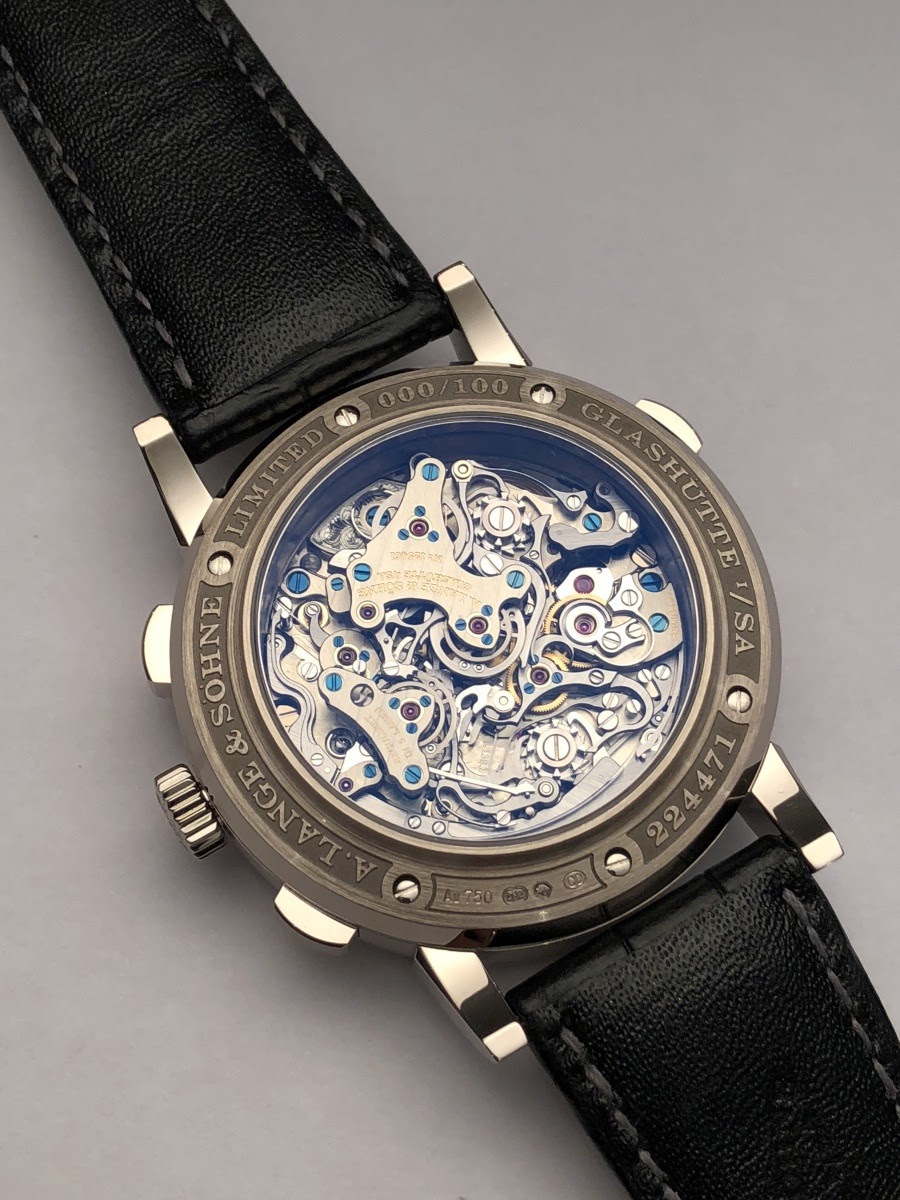
Anyway, the caliber L132.1, like the L001.1, is a real wonder to use. Whenever we are starting, stopping, launching the fly-back, using the rattrapante (by splitting or gathering the hands), the firmness of the pushers is set as in a dream and the feeling experienced by the owner of the watch is unique. On this point, undoubtedly, there is Lange and the others. However, from a pure ergonomic point, I have to confess that I prefer the solution based on a monopusher chronograph with a rattrapante pusher on the same caseside. The fact that the split-seconds pusher is at 10 o'clock forces to operate a small gymnastics with the fingers. Finally, the manual winding of the movement also provides a rare pleasure. Despite the increase in the power reserve, everybody will be happy to wind the watch every day!
The Triple Split is an exclusive watch and is aimed at collectors who are aware that a rattrapante chronograph caliber is by definition a movement of absolute complexity. But these collectors must also have a beefy wrist to enjoy it because if the Triple Split is not bigger than the Double Split, it's not smaller either! The watch is imposing and heavy and you have to like the watches that weigh a lot... what is my case! Fortunately, a white gold folding clasp comes with the watch and it allows a better and a firmer position on the wrist. The Triple Split is indeed the absolute chronograph: it must be deserved to take full advantage of what is, in my opinion, the most beautiful chronograph movement of the industry. The reward is worth the effort!

The Triple Split is available in the context of a limited edition of 100 pieces with a price of 139.000 euros including taxes in France.
Pros:
+ the most beautiful chronograph movement of the industry
+ the increase in the power reserve
+ the discreet presence of the hours counter which preserves the classic dial balance of the Double Split
+ the colors range which is very elegant
+ the almost identical proportions compared to that of the Double Split ...
Cons:
- ... but still very big!
- the location of the rattrapante pusher is not very ergonomic
- the continuous hands of the hours counter
- I would have used a platinum case for the first edition of the Triple Split
Fr.Xavier
Lange & Söhne has marked the history of the contemporary chronograph (at least) twice: with the release of the Datograph in 1999 and with the presentation of the Double Split in 2004. The Datograph redefined how should be ideally the classic chronograph of the high end segment, with a low frequency and a jumping minute counter. The movement was not just a treat for the eyes. It was also totally adapted to a daily use thanks to the very enjoyable winding experience, the perfect sensation caused by the use of the pushers and the flyback feature. The Double Split was created in a similar context but with a higher frequency (3hz vs 2.5hz) and especially by making the "rattrapante" function much more useful because it could measure the additive and comparative times up to 30 minutes: it was the first watch to offer such a performance. Rarely a watch has worn a name describing it so well: Double Split evokes the double-rattrapante mechanism symbolized by the two pairs of hands (those of the seconds and minutes of the chronograph) which separate ... and gather according to the use of the chronograph, for example to measure intermediate times or the performance of two competitors.

The Double Split was until now considered as the ultimate chronograph, because of its technical characteristics, its size, its finishes. But it has just found a successor with the Triple Split which was unveiled a few days ago in Geneva during the last SIHH.
The Triple Split is not difficult to explain: it is totally in line with the Double Split. Triple Split as triple-rattrapante and, after the seconds and minutes, the hours are now the subject of the same treatment. The consequence is quite logical: thanks to the ability of splitting the hands from the hours counter, the Triple Split is able to measure additive and comparative times over a period of 12 hours. The use of the Triple Split is identical to that of the Double Split: the rattrapante pusher is located close to 10 o'clock while the pushers for starting, stopping and resetting the chronograph are located on the right caseside.
On the other hand, the presentation of the dial changes between the Double Split and the Triple Split. Admittedly, I find again the two sub-dials which are slightly off-centered down: the left one is dedicated to the permanent second hand, the right one to the minute counter of the chronograph. In the same way the flange is still occupied by the tachymeter scale. The small displays bring the true novelty. First, the power reserve indicator goes from the top of the dial to its bottom. The Triple Split therefore uses a similar configuration than the Datograph Up & Down with this position. Then, the top of the dial is now occupied by the brand new hours counter that embodies the transition from Double to Triple Split.

So, perhaps to make a clearer difference between these two watches, Lange & Söhne made the decision to use a colors range that was not used with the Double Split. In a strange way I must confess, the first version of the Triple Split is released in white gold. I expected, considering the exclusive nature of the watch (edited in the context of a limited series of 100 pieces) and the prestige of the complication that a platinum case should be dedicated to it. The gray dial (a consistent color with the white gold case for Lange & Söhne) defines a very different style from that of the Double Split. Fortunately, the contrast remains between the dial and the sub-dials even if it is less clear than with the black dial of the Double Split in platinum. The manufacture was also keen to bring a nice contrast between the rattrapante and the chronograph hands. The hands of the rattrapante function, in blued steel, are distinctly distinguished from those of the chronograph, which are made of rhodium-plated steel. I really liked the design of the dial, very elegant and in my opinion, more refined than the Platinum Double Split. The Roman numerals of the first version of the Double Split don't come back (it was already the case with latter versions of the Double Split) but it is for the good cause: there isn't any space left and Lange ensured that the case dimensions remain almost identical.
The real performance is at this level: despite the addition of a "split" hours counter, despite the increase in the power reserve from 38 to 55 hours, the size of the movement of the Triple Split is similar to that of the Double Split. Its diameter is the same (30.6mm) and it even has the luxury of being thinner (9.4mm vs 9.5mm). So, the logical consequence is that the case of the Triple Split has the same diameter than the Double Split one (43,2mm) but, because of the additional display which must oblige to slightly raise the main hands, its thickness is slightly higher ( 15.6mm vs 15.3mm). We almost don't feel any difference between the two cases!

The Triple Split is animated by the caliber L132.1 with a 3hz frequency, like any Lange & Söhne's split-seconds chronograph movement. Visually, it differs little from the caliber L001.1 of the Double Split. I find again with great pleasure the magnificent finishes of the manufacture, the striking depth effects that give the impression of a multi-layer construction, the two column wheels and all the moving parts that define a kind of mechanical lace. The challenge was therefore the addition of the additional mechanism and the increase of the power reserve while maintaining an identical size. The watchmakers of the manufacture have optimally used the spaces available or created due in particular to the change of location of the power reserve display (my assumption is that the increase in the power reserve comes from the removal of the maltese cross like it was done with the Datograph). Just as with the Double Split, they worked on the stability of the movement behavior when the minute counter hand jumps instantly thanks to a disagengement system. However, this system is not present on the mechanism of the hours counter since the hands are rotating slowly and continuously. This change compared to the minutes counter is not inconvenient from the strict practical point of view but I would have liked that the hour hands could "jump" (by half-hour due to the 30 minutes counter) like the minutes hands. I imagine that this option would have resulted in more complex changes to the movement.

Anyway, the caliber L132.1, like the L001.1, is a real wonder to use. Whenever we are starting, stopping, launching the fly-back, using the rattrapante (by splitting or gathering the hands), the firmness of the pushers is set as in a dream and the feeling experienced by the owner of the watch is unique. On this point, undoubtedly, there is Lange and the others. However, from a pure ergonomic point, I have to confess that I prefer the solution based on a monopusher chronograph with a rattrapante pusher on the same caseside. The fact that the split-seconds pusher is at 10 o'clock forces to operate a small gymnastics with the fingers. Finally, the manual winding of the movement also provides a rare pleasure. Despite the increase in the power reserve, everybody will be happy to wind the watch every day!
The Triple Split is an exclusive watch and is aimed at collectors who are aware that a rattrapante chronograph caliber is by definition a movement of absolute complexity. But these collectors must also have a beefy wrist to enjoy it because if the Triple Split is not bigger than the Double Split, it's not smaller either! The watch is imposing and heavy and you have to like the watches that weigh a lot... what is my case! Fortunately, a white gold folding clasp comes with the watch and it allows a better and a firmer position on the wrist. The Triple Split is indeed the absolute chronograph: it must be deserved to take full advantage of what is, in my opinion, the most beautiful chronograph movement of the industry. The reward is worth the effort!

The Triple Split is available in the context of a limited edition of 100 pieces with a price of 139.000 euros including taxes in France.
Pros:
+ the most beautiful chronograph movement of the industry
+ the increase in the power reserve
+ the discreet presence of the hours counter which preserves the classic dial balance of the Double Split
+ the colors range which is very elegant
+ the almost identical proportions compared to that of the Double Split ...
Cons:
- ... but still very big!
- the location of the rattrapante pusher is not very ergonomic
- the continuous hands of the hours counter
- I would have used a platinum case for the first edition of the Triple Split
Fr.Xavier
Comments:

Pretty Boy January 23rd, 2018-14:19
Thanks a lot for this fantastic review, Fx. This triple split chrono is a great achievement indeed. It’s beautiful too. Best, Volker


Arie - Mr Orange January 23rd, 2018-14:25
They should have used a steel case for the first edition No message body


Arie - Mr Orange January 23rd, 2018-15:02
;-) Well, think about the press it would get. And that watch in steel (24 pcs) would reach instant cult status.

Gelato Monster January 23rd, 2018-18:13
Steel weight Would make it even more wearably attractive.
BABKA January 24th, 2018-19:32
And even more expensive for sure. Cult status for sure.

Alkiro1 January 23rd, 2018-14:28
Thank you FX for this great review. Regarding this watch, I’m always amazed by the depth of its caliber. Impressive! Best wishes Alkiro

russell996 January 23rd, 2018-14:42
Great report. I have it in writing from Lange that there will be no other versions of the Triple Split - no other metals.

foversta January 23rd, 2018-14:53
Thanks for the information... we will see in the future! ;-)
0-10-10
Load More Comments
Next Article
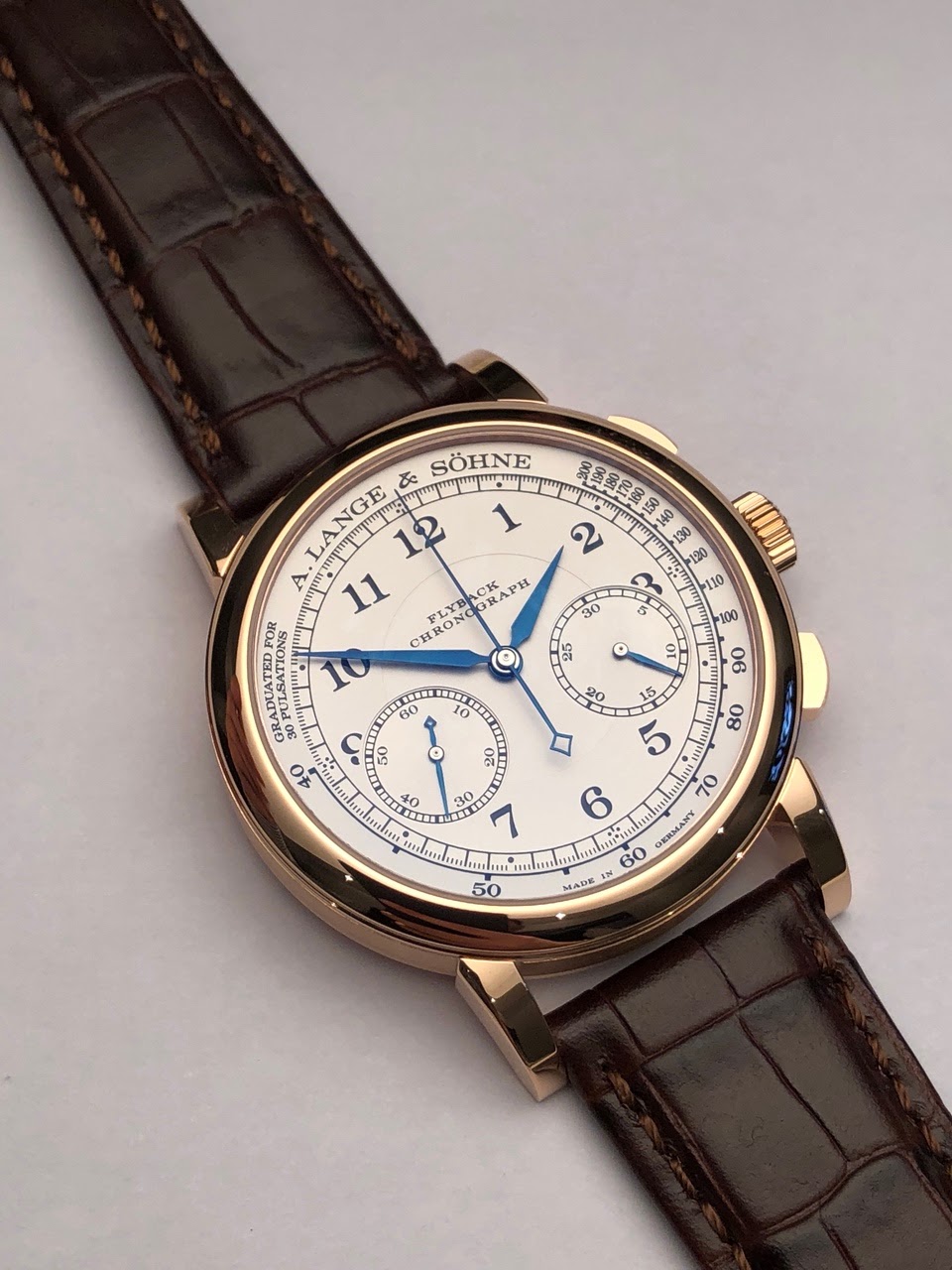
foversta


SIHH 2018 live: Lange & Söhne
foversta


Lange introduced: The Triple Split in white gold100 pieces German price is 139,000 euros with taxes The 1815 Homage to Walter Lange in gold with a price of 47,400 euros The Saxonia Thin with a blue brillance dial with a price of 21,000 euros The Saxonia Outsize Date with a price of 24,700 euros The Saxonia Moonphase with black dial with a price of 28,700 euros New colored dials for the Little Lange One with a price of 32,800 euros PG versions of the 1815 chroongraph with a price of 49,400 euros .
© 2017 - WatchProZine